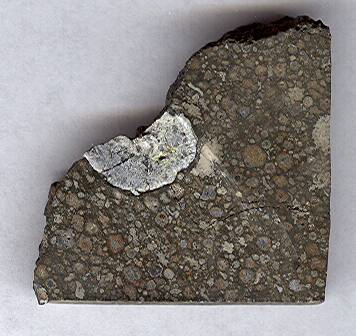The phrase “older than dirt” has taken on new meaning in scientific communities, with the recent analysis of a primitive meteorite from Northern Arizona University’s Meteorite Repository Collection that has scientists declaring it the oldest known material in the solar system.
The meteorite—which NAU purchased in Morocco in 2004 and is known as Northwest Africa 2364—is part of a collection maintained by NAU geologists Jim Wittke and Ted Bunch. The duo frequently provides meteorite samples on request to scientists for their investigations. Such was the case when two researchers from Arizona State University—Audrey Bouvier and Meenakshi Wadhwa—requested a piece of Northwest Africa 2364 from NAU to measure its ratio of two lead isotopes as a way to more accurately date the material.
Their findings dated the piece at 4.568 billion years old, or nearly 2 million years older than the oldest materials found in other meteorites.
“This is significant in that some of the most important events that shaped the solar system occurred within the first few million years of its formation,” Bunch said, explaining that this relatively small age adjustment means there was at least twice the amount of iron-60 in the early solar system than previously known. “A greater volume of this short-lived isotope of iron can only be explained by supernova injection—an event that could have triggered the formation of the solar system.”
Bouvier and Wadhwa’s findings were published earlier this month in Nature Geoscience and Scientific American magazine.
Wittke and Bunch are well known for contributing to the understanding of the origin and evolution of the solar system. For nearly 10 years they have classified and studied more than 1,000 meteorites, which include 22 lunar and 14 Martian meteorites, and have published dozens of research papers on the topic.
“We have probably classified more meteorites than any group in the world, with the exception of those dedicated to classifying the National Science Foundation-sponsored Antarctic collection, which numbers in the tens of thousands,” Bunch said.
Bunch, a former NASA researcher who specializes in impact craters, has a main-belt asteroid named after him. He and Wittke are part of a team of international researchers who in 2007 reported evidence that a comet or low-density object barreling toward Earth exploded in the upper atmosphere and may have wiped out most of the large animals, their habitat and humans during the ice ages about 13,000 years ago.



